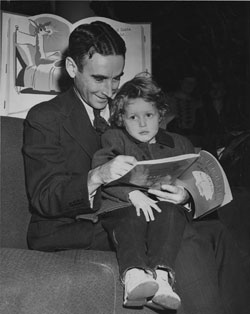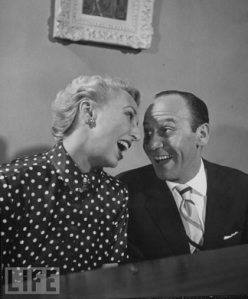Regarding Rudolph
‘Twas the day before Christmas and all through the hills
The reindeer were playing . . . enjoying the spills ”
Thus begins Robert May’s charming and lighthearted poem in anapestic tetrameter, (the same meter as “A Visit from St. Nicholas” ––also known as “‘Twas the Night Before Christmas”).
While it’s a common complaint that holiday traditions and stories have become too commercialized, this beloved tale actually began as a commercial gimmick.
Robert May created the concept of a misfit reindeer in 1939 at the behest of his employer, the Montgomery Ward department store in Chicago. Ward’s had traditionally given a free coloring book to children at holiday time. That year, store executives decided it would be more cost-effective to create an original children’s book in-house. They didn’t know exactly what they wanted, but had the notion it should be an animal story with a main character like Ferdinand the Bull. They gave Robert May, a 35 year-old Jewish copywriter, the project because he was known for his witty impromptu party limericks. As creative and well-suited to penning this poem as May was, the timing couldn’t have been worse. His young wife was dying of cancer, most of his meager salary was going to her medical treatments, and he had a four year-old daughter, Barbara to raise. Several months into the manuscript, May’s wife died, and his boss offered to take the project off his hands. By then attached to the work-in-progress, May refused to let it go. He continued to work on the story by night, using Barbara as a sounding board.
When he first presented his concept, it fell flat with the corporate executives who pointed out that bulbous red noses were associated with alcoholism. Not willing to relent, May convinced his friend and coworker, illustrator Denver Gillen, to create an adorable, child-friendly character. After a number of research trips to the Lincoln Park Zoo, the story came to life in pictures, and Montgomery Ward gave the project the green light. (Click here to view that original, handwritten, illustrated manuscript.) The first year, more than two million copies Rudolph the Red-Nosed Reindeer were handed out and the public fell in love with the story. The verses best come to life when read aloud, as in the video below.
Although the story of Rudolph was “work for hire,” and therefore belonged to Montgomery Ward, the corporation allowed the rights to the intellectual property to revert to Robert May after he fell upon hard financial times. His brother-in-law, songwriter Johnny Marks then wrote new verses for the story, set it to music, persuaded Gene Autry to record it, and it became a hit. The song’s success paved the way for many more commercially successful ventures including the 1964 animated TV special starring Burl Ives.
Robert May eventually remarried a coworker, converted to Catholicism, and had five more children. He left Montgomery Ward because managing Rudolph became a lucrative full-time job. May died in 1976, but his Christmas story lives on. True to the song, Rudolf the Red-Nosed Reindeer has, indeed, gone down in history!
Opossum Carols, or Walt Kelly’s Xmas Postludicrosity
As the first snows of December drift across my South St Louis windows, and the last shards of Thanksgiving turkey find their way into the requisite casseroles, cold cuts, and cauldrons of stock, I find myself harkening back to early Advent Sundays of yore.
My childhood, like so many others, was loaded with the humor of the holidays, but one of my family’s favorite traditions always tended in a more marsupial direction. So if you’ie got some time between mixing tubs of “Tom and Jerry” and trimming the tree, I’d like to share one of many meaningful excursions through the absurd quadrants of kiddie Christmas culture.

As I boy growing up in Detroit in the 1970s, I loved watching my mother collapse the last of her gargantuan Thanksgiving feast into a few impossibly crammed Tupperware containers and stuff the serving platters, gravy boats, and silver-plate cutlery away for their long sleep through the seasons until the following November.
While my father wrestled with the Christmas tree and cursed our cat as it grinned Cheshire-style from the upper branches, my mother would softly sing carols to herself or hum along to the holiday classics on the kitchen radio. My family loved Christmas for many reasons – togetherness, food, faith, and even frantic shopping – but mostly we adored the way it gave rise to an unusual number of opportunities for great stories and copious laughter. Those post-Thanksgiving radio carols were our first inklings that more manic Christmas cheer would soon come rolling in on an eggnog tsunami of tinsel, gingerbread, Grinches, and Good Old Charlie Brown holiday specials.
Every year, though, one particular tune ran a bit askew of the more traditional standards. My mother was hardly a musical person. She could never carry a tune and she famously celebrated the destruction of our family piano, relishing the thought that she had saved her son from the miserable lessons she detested as a child. Yet, she loved Christmas music of all stripes, and one particularly eclectic ditty above all else.
In the Archives: Thomas Nast and Santa Claus (1862-1890)
I can remember my first scholarly thought. Well, I should say that I can visualize the context of my first scholarly thought. Like a Polaroid of a younger me looking through a View-Master: I know that I saw something, and how, but can’t remember what.
I can almost replicate the place from memory, but will never replicate the time. Heraclitus, who was smarter than the average Greek, once wrote fragmentedly, “You cannot step into the same river, for other waters and yet others go ever flowing on.” True, but the Greeks widely preached the maxim to “Know Thyself,” and I remember helping my grandfather once, and being rewarded with a copy of Mark Twain’s The Adventures of Huckleberry Finn.
To be precise it was The Annotated Huckleberry Finn, edited by Michael Patrick Hearn, copyright 1981 by Clarkson N. Potter, republished by Norton & Company. When my grandfather gave me the book it was still new scholarship, and I was no scholar, but the text fascinated me. Densely illustrated, the Potter edition uses marginalia to communicate the context of both the novel and Hearn’s Introduction like an analogue prototype for the internet. I was a babe in the woods, looking through the first book I ever owned that did not involve talking animals or a young sleuth by the name of Encyclopedia Brown. I was proud that someone thought me ready for such an impressive text, but make no mistake, the pictures helped. As a child I was not a strong reader, but I was wildly artistic. And the first page I opened had a caricature of two men, in nightgowns, with nineteenth-century facial hair, collecting clocks.
I don’t think I can reproduce it here for legal purposes, but Roman numeral lvi (56) of the Norton edition will show you the two figures identified as the authors George W. Cable and Mark Twain, drawn by Thomas Nast, on Thanksgiving, 1884.
There was no other description behind the cause of their act, collecting clocks at five before midnight, besides: “The two spent Thanksgiving at Thomas Nast’s home in Morristown, New Jersey.” I cannot fault Hearn’s lack of insight, because it sparked the first real academic inquiry in my young mind: What the hell is going on?
I can tell you that later I learned:
On Thanksgiving Eve the readers were in Morristown, New Jersey, where they were entertained by Thomas Nast. The cartoonist prepared a quiet supper for them and they remained overnight in the Nast home. They were to leave next morning by an early train, and Mrs. Nast had agreed to see that they were up in due season. When she woke next morning there seemed a strange silence in the house and she grew suspicious. Going to the servants’ room, she found them sleeping soundly. The alarm-clock in the back hall had stopped at about the hour the guests retired. The studio clock was also found stopped; in fact, every timepiece on the premises had retired from business. Clemens had found that the clocks interfered with his getting to sleep, and he had quieted them regardless of early trains and reading engagements. On being accused of duplicity he said: “Well, those clocks were all overworked, anyway. They will feel much better for a night’s rest.” A few days later Nast sent him a caricature drawing—a picture which showed Mark Twain getting rid of the offending clocks. (Mark Twain, a Biography, vol. II, part 1, 188)
But all this postdates my first academic thought. Before I knew Huck, Jim, the Mississippi River, or the author who sent them down it. I saw a picture and knew the name of the man who drew it. Thomas Nast. I remember I wanted to know more, and now I can share some of it with you, in context.
Baby, It’s Cold Outside
It’s the holidays – that all-encompassing term we use to describe this time of year when we celebrate Thanksgiving, Christmas, Hanukkah, New Year’s, Kwanzaa, the winter solstice or whatever else you wish to add to your holiday list. The more the merrier. But when it comes to popular music, Christmas is by far the most significant holiday of the season. Christmas music is more than a genre of popular music; it has become an entire industry unto itself. Christmas songs cover virtually all aspects associated with the holiday, from the specific to the seasonal at large. From sacred songs about the birth of Jesus to silly songs about snowmen and Santa, to songs about winter weather or winter romance. Virtually every culture that celebrates Christmas has their own offering to the genre, from finding humor in ethnic stereotypes such as “Donde Esta Santa Clause” or “Dominick the Italian Christmas Donkey,” to specific regional American subcultures like Alan Jackson’s “Honky Tonk Christmas” or James Brown’s “Santa Clause Go Straight to the Ghetto.”
“Christmas” is a feeling bigger than the specific day and, as a federal holiday, the atmosphere created by the general public discourse this time of year is inclusive for all Americans to enjoy. This is as true with music as with anything. One certainly does not need to be a Christian – or religious in any way whatsoever – to enjoy Dean Martin crooning “The Christmas Blues” or Charles Brown pleading his baby to “Please Come Home For Christmas” or The Ronettes inviting you to take a “Sleigh Ride,” or Judy Garland’s heart-wrenching “Have Yourself a Merry Little Christmas” from Meet Me In St. Louis – one of American cinema’s greatest moments. Somehow, “Have Yourself a Merry Little Holiday” just lacks the same punch. Continue reading →





